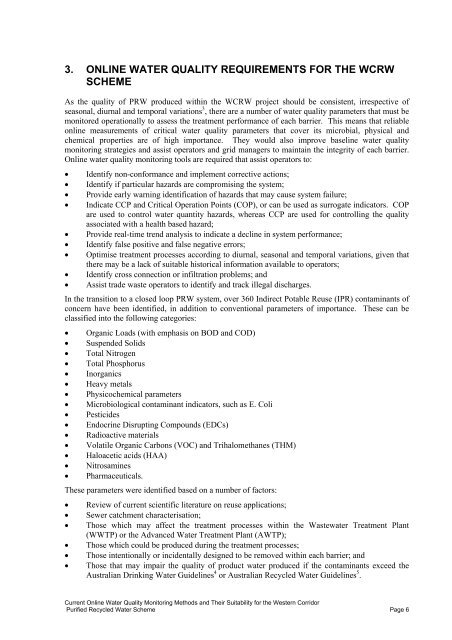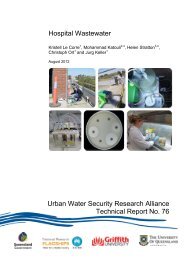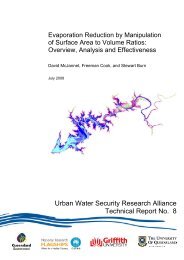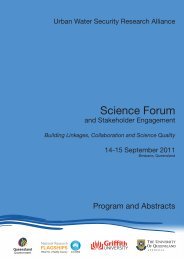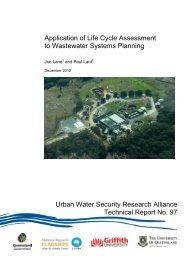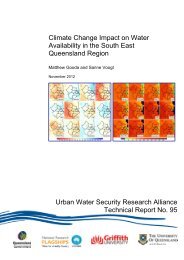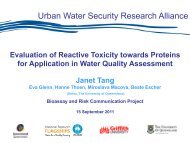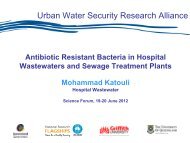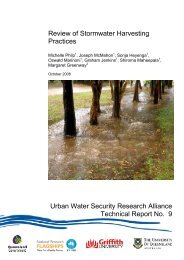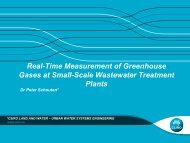3. ONLINE WATER QUALITY REQUIREMENTS FOR THE WCRWSCHEMEAs the <strong>quality</strong> of PRW produced within the WCRW project should be consistent, irrespective ofseasonal, diurnal <strong>and</strong> temporal variations 3 , there are a number of <strong>water</strong> <strong>quality</strong> parameters that must bemonitored operationally to assess the treatment performance of each barrier. This means that reliable<strong>online</strong> measurements of critical <strong>water</strong> <strong>quality</strong> parameters that cover its microbial, physical <strong>and</strong>chemical properties are of high importance. They would also improve baseline <strong>water</strong> <strong>quality</strong><strong>monitoring</strong> strategies <strong>and</strong> assist operators <strong>and</strong> grid managers to maintain the integrity of each barrier.Online <strong>water</strong> <strong>quality</strong> <strong>monitoring</strong> tools are required that assist operators to:Identify non-conformance <strong>and</strong> implement corrective actions;Identify if particular hazards are compromising the system;Provide early warning identification of hazards that may cause system failure;Indicate CCP <strong>and</strong> Critical Operation Points (COP), or can be used as surrogate indicators. COPare used to control <strong>water</strong> quantity hazards, whereas CCP are used for controlling the <strong>quality</strong>associated with a health based hazard;Provide real-time trend analysis to indicate a decline in system performance;Identify false positive <strong>and</strong> false negative errors;Optimise treatment processes according to diurnal, seasonal <strong>and</strong> temporal variations, given thatthere may be a lack of suitable historical information available to operators;Identify cross connection or infiltration problems; <strong>and</strong>Assist trade waste operators to identify <strong>and</strong> track illegal discharges.In the transition to a closed loop PRW system, over 360 Indirect Potable Reuse (IPR) contaminants ofconcern have been identified, in addition to conventional parameters of importance. These can beclassified into the following categories: Organic Loads (with emphasis on BOD <strong>and</strong> COD) Suspended Solids Total Nitrogen Total Phosphorus Inorganics Heavy metals Physicochemical parameters Microbiological contaminant indicators, such as E. Coli Pesticides Endocrine Disrupting Compounds (EDCs) Radioactive materials Volatile Organic Carbons (VOC) <strong>and</strong> Trihalomethanes (THM) Haloacetic acids (HAA) Nitrosamines Pharmaceuticals.These parameters were identified based on a number of factors:Review of current scientific literature on reuse applications;Sewer catchment characterisation;Those which may affect the treatment processes within the Waste<strong>water</strong> Treatment Plant(WWTP) or the Advanced Water Treatment Plant (AWTP);Those which could be produced during the treatment processes;Those intentionally or incidentally designed to be removed within each barrier; <strong>and</strong>Those that may impair the <strong>quality</strong> of product <strong>water</strong> produced if the contaminants exceed theAustralian Drinking Water Guidelines 4 or Australian Recycled Water Guidelines 5 .<strong>Current</strong> Online Water Quality Monitoring Methods <strong>and</strong> Their Suitability for the Western CorridorPurified Recycled Water Scheme Page 6
The number of parameters per category that are required to be measured within each barrier to ensurethat treatment efficiency can be maintained is shown in Table 1.0. While it is difficult to monitor forall parameters, especially IPR contaminants of concern, it is highly recommended that specific hazardswhich may influence the final <strong>quality</strong> should be monitored continuously. In addition, <strong>online</strong> sensorsthat could be used as surrogate parameters for important contaminants that cannot be currentlymeasured in real-time would also be highly desirable. Therefore it is recommended that wherepossible, <strong>online</strong> <strong>monitoring</strong> of treated <strong>water</strong> should be instituted for all contaminants or indicators thatpose a human health risk 3 .The following section briefly describes each treatment barrier within the WCRW scheme <strong>and</strong> detailsideal <strong>online</strong> analyser requirements.Barrier 1Barrier 1 focuses on the control of industrial, commercial <strong>and</strong> residential source waste<strong>water</strong> enteringthe sewer catchment from a significant number of entry points. It is one of the most important barriers<strong>and</strong> it must be controlled effectively 3 , as production of high <strong>quality</strong> PRW is dependent on the <strong>quality</strong>of source <strong>water</strong> obtained from the sewer catchment.Therefore, <strong>online</strong> <strong>water</strong> <strong>quality</strong> <strong>monitoring</strong> technology required for Barrier 1 must be capable ofoperating:Reliably <strong>and</strong> accurately for prolonged periods of times;Robustly in a range of harsh measurement environments from industrial, commercial <strong>and</strong>residential sources, without being affected by matrix interferences; <strong>and</strong> Continuously <strong>and</strong> reliably in highly turbid environments where suspended solids concentrationsare high. Hence, <strong>online</strong> analysers employed in this barrier must be resistant to biofouling, signaldrift <strong>and</strong> blockages.It should be noted that obtaining reliable, low maintenance, continuous <strong>online</strong> analysis at this barrier isa real challenge using currently available commercial systems due to the complex nature of themeasurement environment.Barrier 2The WWTPs are responsible for the treatment processes associated with Barrier 2. These are existinginfrastructure <strong>and</strong> have been primarily designed for the removal of suspended solids, organic matter<strong>and</strong> nutrients. Treatment effectiveness has traditionally been monitored using parameters such asBiochemical Oxygen Dem<strong>and</strong> (BOD), Chemical Oxygen Dem<strong>and</strong> (COD), Total Nitrogen <strong>and</strong> TotalPhosphorous. Although there is only one entry <strong>and</strong> exit point to the WWTP, the measurementenvironment is still considered extreme <strong>and</strong> harsh for <strong>online</strong> analysers 6 due to the complexity of thesample matrix 7 . In addition, the treatment processes are exposed to ambient conditions <strong>and</strong> as aconsequence the analysers may also be influenced by environmental factors such as temperature <strong>and</strong>humidity 8 .To enable reliable <strong>and</strong> continuous <strong>online</strong> <strong>water</strong> <strong>quality</strong> information at this treatment barrier, <strong>online</strong>analysers must:Function in raw sewage influents of heterogeneous <strong>and</strong> variable compositions, with high <strong>and</strong>variable turbidity, nutrients, COD, BOD <strong>and</strong> suspended solids concentrations.Function in a treated waste<strong>water</strong> sample matrix, which has a significantly lower turbidity, COD,BOD, suspended solids <strong>and</strong> nutrient concentration.Function reliably irrespective of seasonal, diurnal <strong>and</strong> temporal variations, including widevariations in hydraulic flow.Be resistant to sensor biofouling <strong>and</strong> signal drift to ensure that calibration can be maintained.Calibration intervals must be at most daily, however longer periods of time would be preferred.Must be able to function adequately irrespective of sample matrix conditions, to reducemeasurement errors.<strong>Current</strong> Online Water Quality Monitoring Methods <strong>and</strong> Their Suitability for the Western CorridorPurified Recycled Water Scheme Page 7


